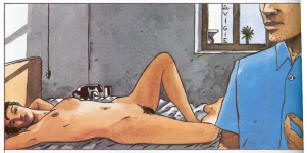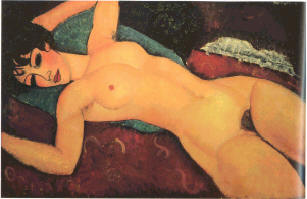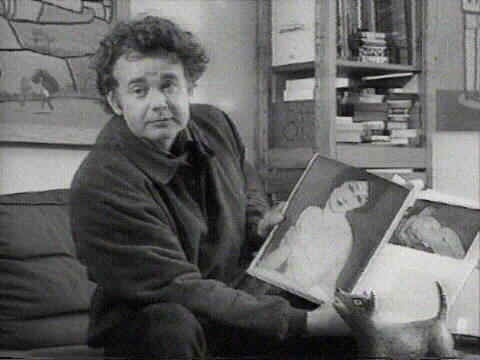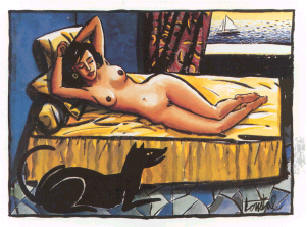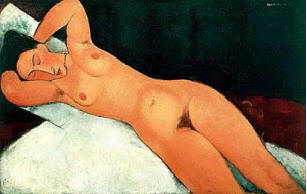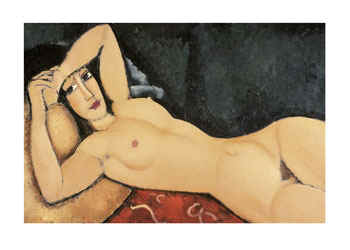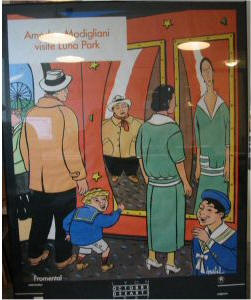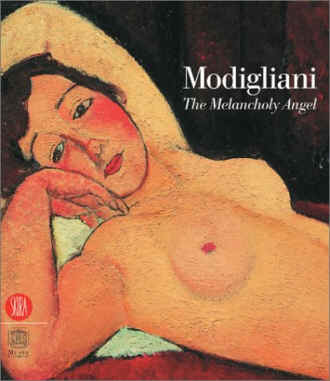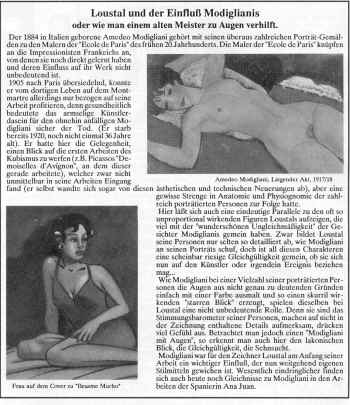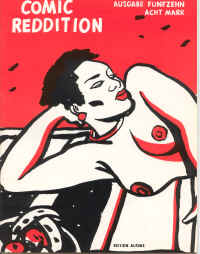"Art Loustal" : Jacques de Loustal / Amedeo Modigliani
| Loustal: Je préfère les
peintres instinctifs et figuratifs. Les peintres du début du siècle
Matisse, Modigliani, Gauguin. Tous les peintres allemands de "
la nouvelle subjectivité ", Beckmann, Grosz, Otto Dix. Et bien sûr,
Hopper, Hockney, Balthus, pour l'immobilisme. (Itinéraire dans l'univers de la bande dessinée , Michel-Edouard Leclerc page 186)
|
 Amedeo Modigliani: Protraits and Nudes (Pegasus Library) by Anette Kruszynski, Hardcover: 120 pages ; Publisher: Prestel USA; (August 1996) ISBN: 3791316745 |
|
|
|
|
|
|
DRUCK |
| Nude with Necklace,
1917
A beautiful naked woman is put on show. The artist presents her as if she were a precious object. She is the embodiment of feminine enticement, and not even a hint of a scarf or sheet conceals her. Only a necklace of fine pearls adorns her neck. She has sunk into sleep and does not care who looks at or paints her. No servant girl disturbs our observation of her. The artist relishes the flawlessness of her body, the warm flesh tones, and the perfect contours of her figure. In order better to accentuate her womanliness, he brings his subject as close to the observer as possible, choosing to forgo showing her all the way down to her feet. Our meditative contemplation of the painting contrasts sharply with the tremendous scandal which nudes like this originally provoked.
In 1917, when Amedeo Modigliani created such
uncompromising images, the police felt provoked by the nudes to
such an extent that they forbade the artist from showing them in
public, resulting in the abrupt closure of the only solo show that
the artist was to hold in his life. Modigliani was notorious not
only as a synonym for scandal, but above all for his excessive use
of drugs and alcohol and his passionate involvements with women.
As an artist, Modigliani, a native Italian who emigrated to France,
stood between the poles of the traditional and the modern
reflected by those two countries. He hoped to measure his
knowledge of the Old Masters against modern styles, yet he failed
to find his proper place in Paris, the center of the avant-garde,
and came to ruin in the clash between the world of conservative
Salon painting of the fin de siècle and that of avant-garde
movements such as Cubism and Fauvism. Modigliani's goal was to
portray human beings. With only a few exceptions, his entire
oeuvre consists of images of people. The artist perfected his art
of the portrait in the period around 1916 when he created works
like the Portrait of Max Jacob, in which he assimilated elements
such as a cubistic fragmenting of forms as well as principles of
"primitive" sculpture. But Modigliani's style was soon
to change. The hard forms which often seemed to conflict with each
other developed into soft, flowing figurations. Under the
influence of the sun of southern France Modigliani created
lighter-toned portraits with elongated faces and almond-shaped
eyes. His nudes are among his most famous works, and yet they
account for no more than a tenth of his entire output - hardly
more than thirty works. Only a few nudes provoke through tense,
offensive aggressivity. For the most part the artist, in works
such as this one, celebrates the beauty of the female body and
bases his compositions on the work of famous precursors such as
Titian, Goya, and Ingres. Nude with Necklace also recalls the work
of the Old Masters; the outstretched body exudes the same relaxed
sense of inner peace which Giorgione had given his Sleeping Venus
of 1508. Modigliani was no champion of political programs or
manifestos. His thought was firmly grounded in late 19th-century
notions, and the novels of Gabriele d'Annunzio as well as the
verses of Dante Alighieri and Lautréamont were his constant
companions. And just that is the fascination of Modigliani's work:
the conflict between retrospective sentiment and a modern sense of
style which resulted in the last great contributions to the art of
the organically rendered human form. A. K. Amedeo Modigiiani 1884 Amedeo Modigliani is born on July 12 in Livorno 1898-1900 Studies painting under Guglielmo Micheh at the art school in Livorno 1902 Studies at the Scuola Libera Nudo de l'Accademia di Belle Arti in Florence 1903-05 Studies at the Istituto di Belle Arti in Venice 1908 Moves to Paris; attends the Académie Colarossi 1908 Takes part in the Salon des Indépendants in Paris 1909 Makes the acquaintance of Juan Gris and Constantin Brancusi; first sculptural works; returns to Italy 1910 Participates in the Salon des Indépendants in Paris 1912 Exhibition of sculptural works at the Salon d'Automne 1914 Meets the art dealer Paul Guillaume 1918 First solo exhibition, at the Galerie Berthe Weill in Paris 1918-19 Sojourns in Nice and Cannes; returns to Paris with Jeanne Hébuterne and their daughter 1920 Dies on January 24 in Paris; Jeanne Hébuterne commits suicide a day later
|
|
|
Loustal und der Einfluß Modiglianis oder wie man einem alten Meister zu Augen verhilft. Der 1884 in Italien geborene Amedeo Modigliani gehört mit seinen überaus zahlreichen Porträt_Gemälden zu den Malern der "Ecole de Paris" des frühen 20.Jahrhunderts. Die Maler der "Ecole de Paris" knüpfen an die Impressionisten Frankeichs an, von denen sie noch direkt gelernt haben und deren Einfluß auf ihr Werk nicht unbedeutend ist. 1905 nach Paris übersiedelnd, konnte er vom dortigen Leben auf dem Montmartre allerdings nur bezogen auf seine Arbeit profitieren, denn gesundheitlich bedeutete das armselige Künstlerdasein für den ohnehin anfälligen Modigliani sicher der Tod. Er starb bereits 1920, noch nicht einmal 36 Jahre alt). Er hatte hier die Gelegenheit, einen Blick auf die ersten Arbeiten des Kubismus zu werfen (z.B. Picassos "Demoiselles d'Avignon", an dem dieser gerade arbeitete), welcher zwar nicht unmittelbar in seine Arbeiten Eingang fand (er selbst wandte sich sogar von diesen ästhetischen und technischen Neuerungen ab), aber eine gewisse Strenge in Anatomie und Physiognomie der zahlreich porträtierten Personen zur Folge hatte. Hier läßt sich auch eine eindeutige Parallele zu den oft so um proportional wirkenden Figuren Loustals aufzeigen, die viel mit der "wunderschönen Ungleichmäßigkeit" der Gesichter Modiglianis gemein haben. Zwar bildet Loustal seine Personen nur selten so detailliert ab, wie Modigliani an seinen Porträts schuf, doch ist all diesen Charakteren eine scheinbar riesige Gleichgültigkeit gemein: ob sie sich nun auf den Künstler oder irgendein Ereignis beziehen mag... Wie Modigliani bei einer Vielzahl seiner porträtierten Personen die Augen aus nicht genau zu deutenden Gründen einfach mit einer Farbe ausmalt und so einen skurril wirkenden "starren Blick" erzeugt, spielen dieselben bei Loustal eine nicht unbedeutende Rolle. Denn sie sind das Stimmungsbarometer seiner Personen, machen auf nicht in der Zeichnung enthaltene Details aufmerksam, drücken viel Gefühl aus. Betrachtet man jedoch einen "Modigliani mit Augen", so erkennt man auch hier den lakonischen Blick, die Gleichgültigkeit, die Sehnsucht. Modigliani war für den Zeichner Loustal am Anfang seiner Arbeit ein wichtiger Einfluß, der nun weitgehend eigenen Stilmitteln gewichen ist. Wesentlich eindringlicher finden sich auch heute noch Gleichnisse zu Modigliani in den Arbeiten der Spanierin Ana Juan.
|
